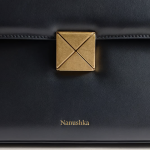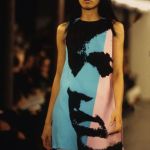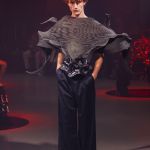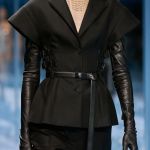
Are we still allowed to criticize a fashion show?
What's going on between Lyas and Dior
October 8th, 2024
A few hours ago, Elias Medini, better known as Lyas, influencer and fashion correspondent for Interview Magazine, posted a video on TikTok where he shared how, after criticizing a recent Paris Fashion Week show (he didn’t specify which, but everyone’s betting on Dior), he was contacted by an industry insider. The individual first asked why he had shared a negative opinion, then suggested that his criticism was fueled by misogyny toward the female designer – not a direct accusation but more of a sanctimonious threat that turns progressivism into a weapon. Medini also discovered that brand employees were slandering him, calling him misogynistic and biased. This story illustrates a reality that all fashion editors – long before influencers – have to face: brand censorship that fearlessly manipulates journalists' opinions. Brand PR, besides serving as the main contact point between the company and the press, also secretly plays the role of fashion's political police – a police force that punishes rebuttal and dissent, with its first and most visible weapon being a phrase that begins with «We’re very sorry you wrote…» and its final (never stated) move being excommunication from the shows and brand events. This is what happened to Cathy Horyn, who was banned from Saint Laurent shows after criticizing Hedi Slimane, and what, silently, happens to many critics whose bad reviews are punished with ghosting and removal from lists, or who simply don’t critique at all for fear of an irrevocable ban. So, it makes us wonder: can we still do fashion criticism?
There are two categories of critics: the classic ones, working within a publication that may or may not have its own policies and diplomatic relations to maintain; and the new ones, who publish reviews on any social platform and in any format. While the former might indeed be bound by the laws of good relations, the latter are the freest when they have little to lose in terms of invitations, ads, or more generally, “access” to brand events. It all varies case by case: a sharp reader can easily see that certain institutional fashion press is subservient to its advertisers simply through the complete lack of any negative notes – but here the issue lies in the true nature of fashion media, especially magazines, which function more as advertising loudspeakers than cultural publications. Not only have magazines always worked as agencies for which brands are both clients and advertisers as well as industry players, but today they act more as broadcasters or “amplifiers” of a narrative set by brands and large industrial groups. If I work with a certain brand, I don’t speak ill of it, and the most acceptable form of criticism is silence; if there’s nothing nice to say, say nothing. This is a problem because the harsh critics of the past “trained” talented designers, while today’s critics celebrate pro forma even mediocre creatives, essentially lowering the standard for what is considered fashion.
Of course, it’s not only magazines that are influenced. Even an independent can be politely coerced into giving a positive review, with the implication that changing their opinion will open the gates of paradise. This happened in recent years with Brenda Waischer, who, after long criticizing Dior, was welcomed to their events and shows, deleted all her old tweets, and crossed over, becoming their most enthusiastic courtier. It’s a clever strategy for brands that have the means to turn enemies into allies. Others require less direct persuasion: the promise of the good life, press trips, and gifts is enough to create sympathies and indirectly buy positive publicity. In such cases, simply looking at their feed to see which shows they’re invited to – usually few and highly commercial – is enough, since the most recognized media and journalists are invited to all the shows, while these individuals depend on one or two brands that are invariably struggling. Whether it’s magazines, influencers, or independent critics, however, silences are more telling than certain words. An unwritten law of fashion press: what is omitted is hated – remember this next time you read the classic round-up of a fashion week.
The absence of adept public critics over the past 20 years has elevated subpar designers. If the new class can begin to really discern and articulate — and develop some cultural and critical literacy around fashion — then things may change.
— savannah (@savbrads) September 29, 2023
Leibowitz said it better, though: https://t.co/v8a2ri8vZl pic.twitter.com/8ZtH65teTq
The truth is that the situation of control and maintenance of rank in fashion criticism has been caused by a power imbalance between brands and the media. In the ’90s, critics were lions because the press (and publishing in general) was the only communication channel to the public: it was a fashion critic, Carmel Snow, who gave Dior's New Look its name; Diana Vreeland launched Edie Sedgwick’s career and was Jackie Kennedy’s style advisor; Isabella Blow brought Lee McQueen out of obscurity, Anna Wintour created John Galliano’s career, and Franca Sozzani nurtured that of supermodels and top fashion photographers working today. With the rise of social media, things changed. Where once journalists were fashion’s gatekeepers, gradually anyone could access shows, discover new brands, spread the word of a new designer, or find a new trend. Newspapers and their critics lost their power because a brand’s success no longer depended on print publications but on their own social media reach, endorsements, or the virality of a post. Over time, even critics fell into conservatism: many have gone down in history for being on the wrong side of it, guilty of dismissing the collections of emerging designers with outdated opinions, only to be disproven by the success of those designers. Lee McQueen, Galliano, and Marc Jacobs are among the most glaring examples.
@showstudio With creative directors being booted out of brands more quickly than ever before, does it come down to the media? #fashiontiktok #showstudio #wordsofwisdom original sound - SHOWstudio
In short, objective criticism transformed (both in perception and partially in practice) and was reduced to mere opinion, with the journalist’s role becoming that of explaining a collection, leaving the public to determine its success or failure. The public, too, became more susceptible to direct marketing than to the press: if journalists’ opinions about certain designers affected sales, many brands would be long gone. In an interview with Highsnobiety, Hanan Besovic, also known as @ideservecouture, said: «When criticizing objects, there’s much more to consider. It used to be just about clothes; now we criticize the entire company and the decisions it makes». A statement that also explains another aspect of the dilemma fashion critics face today: brands’ hypersensitivity to judgments and even indirect opinions. Today, a brand’s PR has no hesitation in calling a newsroom because their brand was mentioned incidentally in an article about something else; they complain about an adjective that isn’t overly positive, a similarity, or a remote association, essentially interfering in every way possible with a publication’s editorial activity. Whereas before they would get angry, today they want to intervene.
It’s not so much freedom of opinion or the press that isn’t recognized, but rather the media’s vassalage that is reinforced: the media is a tool, a channel – it shouldn’t claim autonomy, especially if it could damage business. Of course, brands can’t have the entire press on the payroll, so contrary voices will inevitably arise. Not even the Internet audience helps, given its rejection of any imposed opinion and its partisanship. The pluralistic and relativistic mindset our society has adopted also punishes firm stances and unique viewpoints: if a critic doesn’t like something, it’s because they have an issue; there are many people who do like it, and their collective opinion invalidates the singular one. This type of argument can be called the “But it sells” argument, implying that aesthetic value is subordinate to market law – though by this logic, since Shein sells, it couldn’t be criticized either. This is what formal logic calls an “argumentum ad hominem,” much like in Elias Medini’s case, where it was essentially suggested that if he criticizes a woman’s work, he is a misogynist. Many of the challenges a modern fashion critic faces come from a combination of three factors: the brands' commercial power over the press, the marginalization of criticism itself, and, finally, the lost authority of critics in the post-truth era, who face an increasingly partisan audience. The solution doesn’t exist; the only thing to do is to strive to be truthful and objective with all one’s might. And hope the phone doesn’t ring in the newsroom.


















































